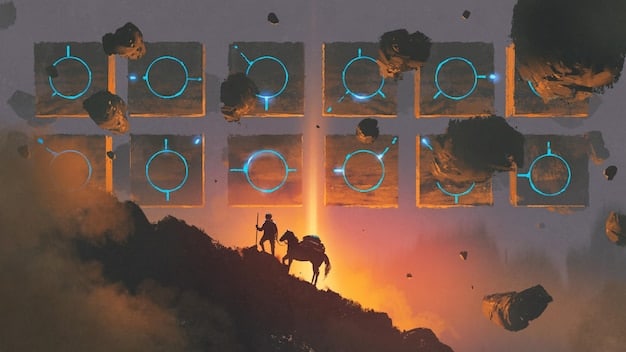Monetization Strategies for Indie Game Developers: Earn Sustainable Revenue

Successful monetization strategies for indie game developers are crucial for securing sustainable revenue streams, enabling continued development, and fostering a thriving creative career in the highly competitive video game industry.
Embarking on the journey of indie game development is often fueled by passion and creativity. Yet, for this passion to become a sustainable career, understanding and implementing effective monetization strategies for indie game developers: earn revenue from your games becomes not just an option, but a necessity. How can you transform your artistic vision into a viable business model?
Understanding the Indie Game Market Landscape
The indie game market has evolved significantly, presenting both immense opportunities and formidable challenges. Gone are the days when a single purchase model was the only viable path. Today, developers navigate a complex ecosystem where visibility is king and player expectations are diverse.
A deep understanding of this landscape is the foundation for any successful monetization strategy. It involves recognizing the sheer volume of games released daily, the various platforms available, and the shifting preferences of player communities. From mobile to PC, and console to VR, each platform carries its own audience demographics and preferred commercial structures.
Market Saturation and Discoverability
One of the primary hurdles for indie developers is market saturation. Thousands of games launch every year across multiple platforms, making discoverability an uphill battle. This means your monetization strategy cannot solely rely on players stumbling upon your game; it must be integrated with effective marketing and community building.
- Visibility: Standing out in crowded digital storefronts requires a proactive approach to marketing.
- Niche Targeting: Focusing on a specific genre or audience can enhance discoverability.
- Community Engagement: Building a loyal player base through early access and consistent communication.
Beyond the sheer number of games, the rise of free-to-play (F2P) models has reshaped player expectations. Many players now anticipate being able to download and try games without an upfront cost, shifting the burden of monetization to post-purchase engagement. This doesn’t mean premium games are obsolete, but it does mean developers must carefully consider their entry points.
The evolving market also means staying abreast of consumer trends, such as the increasing popularity of subscription services like Xbox Game Pass or Apple Arcade, or the growing influence of content creators on platforms like Twitch and YouTube who can significantly impact a game’s reach and success. Adapting to these trends, or even leveraging them, can be a game-changer for independent studios.
Ultimately, a clear vision of where your game fits within this expansive market, coupled with an understanding of prevailing consumer behaviors, is critical. This initial assessment helps developers choose monetization methods that align not only with their game’s design but also with the realities of the contemporary gaming industry.
Premium Sales: The Classic Approach Refined
The premium sales model, where players pay an upfront fee to own the game, remains a viable and often preferred option for many indie developers. While seemingly straightforward, success in this model now requires more than simply releasing a good game; it demands strategic pricing, effective marketing, and a deep understanding of perceived value.
For independent studios, a premium price often signals a commitment to a complete, high-quality experience without the intrusive elements of other monetization forms. This can appeal to a segment of players who prefer a single, clear transaction.
Pricing Strategy and Value Perception
Determining the right price for your game is a delicate balancing act. A price too high might deter potential buyers, while a price too low could devalue your product and leave revenue on the table. Factors influencing pricing include game length, production quality, unique features, and target audience expectations.
- Comparable Titles: Research what similar games are priced at.
- Perceived Value: Ensure the game’s content justifies its price point.
- Regional Pricing: Adjust prices for different economic regions to maximize sales globally.
Beyond the initial price tag, discounted sales and bundle deals can significantly boost revenue and visibility over the game’s lifecycle. Participating in seasonal sales events on platforms like Steam, Itch.io, or console storefronts can introduce your game to new audiences. These strategic price drops can create buzz and attract buyers who might have been hesitant at the full price.

Building a strong narrative around your game’s unique selling points is essential when pursuing premium sales. Players are more likely to invest in a game they perceive as innovative, highly polished, or offering a truly unique experience. This can involve highlighting compelling storylines, innovative gameplay mechanics, or standout art styles.
Furthermore, post-launch content, even if free, can bolster the long-term value proposition of a premium game. Small updates, bug fixes, or even community-driven features can maintain player interest and encourage positive reviews, leading to sustained sales long after release. The premium model, while traditional, is far from static; it requires continuous engagement and strategic adjustments to thrive in today’s dynamic market.
Free-to-Play (F2P) with In-App Purchases (IAPs)
The free-to-play (F2P) model, augmented by in-app purchases (IAPs), has become a dominant force, especially in the mobile gaming sector but increasingly gaining traction on PC and console. This model allows players to download and usually begin playing a game without any upfront cost, with monetization occurring through optional purchases made within the game itself.
The core philosophy behind F2P with IAPs is accessibility. By removing the financial barrier to entry, games can reach a much wider audience, converting a small percentage of engaged players into paying customers. This contrasts sharply with the premium model, where every download represents a direct sale.
Types of In-App Purchases
IAPs come in various forms, each designed to entice players in different ways while maintaining a fair and enjoyable experience. The key is to offer value through purchases without making the game feel pay-to-win or forcing players into purchasing to progress.
- Cosmetic Items: Skins, emotes, and other visual enhancements that don’t affect gameplay power. This is widely accepted and often preferred by players.
- Time-Savers: Items or boosts that accelerate progress or reduce grind, appealing to players with limited time.
- Convenience Items: Additional inventory slots, energy refills, or quality-of-life improvements.
- New Content: Additional levels, characters, or game modes that expand the core game experience.
- Gacha/Loot Boxes: Random chance mechanics for obtaining rare items, though these are increasingly scrutinized by regulators and players.
Balancing player enjoyment with revenue generation is paramount in the F2P model. A poorly implemented IAP strategy can quickly lead to player dissatisfaction and negative reviews. Transparency about purchase mechanics and offering genuine value are essential for building trust with your player base.
Engagement strategies are also critical for F2P success. Daily login bonuses, special events, and continuous content updates encourage players to return frequently, increasing their likelihood of making purchases. Data analytics play a significant role here, allowing developers to understand player behavior, identify monetization opportunities, and refine their IAP offerings based on real-world usage patterns.
Successfully implementing F2P with IAPs requires a delicate art of persuasion, where the core game remains fun and functional for non-paying users, while desirable options exist for those willing to spend. This strategy demands continuous iteration and a deep understanding of player psychology to convert engagement into sustainable revenue.
Subscription Models and Battle Passes
Beyond traditional premium sales and F2P with IAPs, subscription models and battle passes have emerged as powerful tools for predictable, recurring revenue, particularly for games designed for long-term engagement. These models build on the concept of continuous content delivery and exclusive access.
Subscription services, like those seen in massively multiplayer online (MMO) games, offer players access to a game or a suite of games for a periodic fee. This model thrives on providing consistent value and a compelling reason for players to maintain their subscription.
Battle Passes: A Modern Classic
Battle passes have become ubiquitous in many F2P titles, offering a tiered reward system that players can unlock by playing the game over a set period. They typically have a free tier and a premium tier, with the latter offering more substantial and exclusive rewards for a one-time purchase per season.
- Seasonal Content: Provides fresh objectives and rewards every few months.
- Player Engagement: Encourages consistent play to earn rewards and complete challenges.
- Predictable Revenue: Generates recurring income as players purchase new passes each season.
The appeal of battle passes lies in their ability to monetize active players without feeling overtly exploitative. Players purchase the pass knowing they will unlock a variety of cosmetic items, in-game currency, or even gameplay advantages through continued play. This creates a powerful incentive to keep engaging with the game.

For indie developers, a key challenge with both subscription and battle pass models is the need for consistent content creation. Players expect new challenges, items, and experiences regularly to justify their continued payment or engagement. This necessitates a robust development roadmap and a team capable of delivering timely updates.
The subscription model, while less common for standalone indie games, can be successful for studios building a content ecosystem or a platform of smaller, interconnected games. Services like Apple Arcade or Google Play Pass demonstrate the potential for curated game libraries offered under a single subscription, providing an alternative revenue stream for developers who integrate their titles into these programs.
Ultimately, these models are about fostering long-term player relationships. By providing ongoing value, exclusive content, and a clear progression path, developers can cultivate dedicated communities willing to support their games financially on an ongoing basis.
Alternative and Emerging Monetization Strategies
Beyond the established monetization models, the indie game space is a fertile ground for innovation, with developers constantly exploring alternative and emerging strategies to generate revenue. These methods often leverage new technologies, community engagement, or unique value propositions.
The indie spirit encourages thinking outside the box, and this applies directly to how games are funded and sustained. From direct fan support to leveraging blockchain technologies, the options are expanding rapidly, offering developers more flexibility in how they connect with and monetize their audience.
Crowdfunding and Early Access
Crowdfunding platforms like Kickstarter and Patreon have become indispensable tools for many indie developers. They allow studios to secure funding directly from their audience, often before the game is even fully developed. This not only provides capital but also helps build a passionate community from the ground up.
- Kickstarter: Project-based funding with rewards for backers.
- Patreon: Ongoing subscription-like support for consistent content creation.
- Early Access: Releasing an unfinished game to gather feedback and funding while in active development.
Early access, available on platforms like Steam, allows developers to sell their game in an unfinished state. Players gain access to the game and can influence its development through feedback, while developers gain crucial funding and validation. This symbiotic relationship can be incredibly powerful for iterative development and community building.
Advertising and Affiliate Marketing
While often associated with mobile games, advertising can be a subtle monetization tool for other platforms too. Non-intrusive ads, such as rewarded video ads (where players opt-in to watch an ad for an in-game reward), can generate revenue without alienating players. Affiliate marketing, where a game links to relevant products or services and earns a commission on sales, is another nascent area.
The rise of influencer marketing also presents unique opportunities. Partnering with streamers and YouTubers can lead to direct sales through affiliate links or sponsorships. This method leverages the trust and reach of popular content creators to drive game visibility and revenue, often more effectively than traditional advertising.
Emerging technologies like blockchain and NFTs (Non-Fungible Tokens) are also being explored, particularly for in-game asset ownership and trading. While still controversial and in their infancy for mainstream gaming, they represent a potential future for player-owned economies within games. Developers testing these waters aim to provide players with tangible value and new ways to engage with their in-game assets.
These diverse strategies highlight the flexibility available to indie developers. The best approach often involves blending multiple methods, carefully selecting those that align with the game’s design, target audience, and the developer’s unique vision, ensuring a multifaceted and robust revenue stream.
Leveraging Community and UGC for Monetization
In the expansive and interconnected world of gaming, a strong community can be a developer’s greatest asset, not only for feedback and engagement but also as a powerful engine for monetization. By fostering an active player base and empowering user-generated content (UGC), indie developers can create self-sustaining ecosystems that drive both revenue and longevity.
The underlying principle here is that engaged players are more likely to spend money, and players who contribute to the game’s world through UGC deepen their investment in it. This creates a virtuous cycle where community activity directly translates into commercial success.
In-Game Marketplaces and Modding Support
For games with robust modding capabilities, implementing an in-game marketplace where creators can sell their UGC (e.g., custom skins, maps, or levels) can generate revenue for both the creators and the developer. Platforms like the Steam Workshop have proven this model’s viability, allowing developers to take a cut of sales while incentivizing talented community members.
- Monetized Mods: Players buy community-created content, with a revenue split.
- Curated Content: Developers can curate and promote high-quality UGC.
- Increased Engagement: UGC offers endless new content, keeping players invested.
Supporting an active modding community, even without a direct marketplace, can significantly extend a game’s lifespan and appeal, leading to prolonged sales for premium titles or sustained engagement for F2P games. The continued relevance of games like Skyrim or Minecraft years after their release is a testament to the power of UGC.
Beyond direct monetization of UGC, a thriving community can directly influence a game’s financial success through word-of-mouth marketing, positive reviews, and sustained player retention. Active forums, Discord servers, and social media presence create a sense of belonging for players, making them more invested in the game’s future.
Developers can also monetize specific community events, tournaments, or exclusive content tied to community milestones. Limited-edition merchandise, art books, or soundtracks can also be sold directly to passionate fans, leveraging their emotional connection to the game and its world.
Ultimately, by treating their player base as partners rather than mere consumers, indie developers can unlock powerful new revenue channels rooted in shared passion and creativity. The more players feel they are a part of the game’s journey, the more willing they are to support it financially and help it thrive.
Strategic Planning and Long-Term Sustainability
Developing a compelling game is only half the battle; the other half is ensuring its long-term viability. For indie developers, this means not just implementing effective monetization strategies but also embedding them within a broader framework of strategic planning and continuous adaptation. Sustainability is about more than just launch revenue; it’s about building a foundation for future projects and a lasting career.
A well-defined strategy goes beyond choosing a single monetization model; it involves understanding market dynamics, anticipating player needs, and being prepared to pivot when necessary. The indie space is notoriously volatile, and flexibility is key.
Data Analysis and Iteration
In today’s data-driven world, successful monetization relies heavily on analytics. Tracking player behavior, purchase patterns, and engagement metrics provides invaluable insights into what works and what doesn’t. This data enables developers to make informed decisions and iterate on their strategies post-launch.
- Player Retention: Analyze metrics to understand why players stay or leave.
- Conversion Rates: Track how many non-paying users convert to paying customers.
- A/B Testing: Experiment with different pricing, IAP offerings, or store page layouts.
The ability to iterate quickly based on feedback and data is a significant advantage for agile indie studios. This continuous improvement cycle can optimize revenue streams long after the initial release. It means viewing monetization not as a one-time decision but as an ongoing process of refinement.
Furthermore, planning for the game’s entire lifecycle is critical. This includes post-launch content updates, potential expansions, and even considering a sequel or spin-off. Each of these can represent new monetization opportunities, extending the game’s profitable life. A game that earns revenue over several years is often more valuable than one that has a single, large launch spike followed by rapid decline.
Diversifying revenue streams is another cornerstone of long-term sustainability. Relying on a single monetization method can be risky. Combining premium sales with carefully integrated cosmetic IAPs, or using early access to fund a F2P launch with a battle pass, can create a more resilient financial structure against market fluctuations.
Finally, building strong relationships with platform holders, publishers, and the wider game development community can open doors to new opportunities, from featured promotions to publishing deals that ease the financial burden of development and marketing. Strategic planning for indie developers is about building a business, not just a game, ensuring that creativity can flourish alongside commercial success.
| Key Strategy | Brief Description |
|---|---|
| 🎮 Premium Sales | Upfront payment for full game ownership, requiring strong marketing and perceived value. |
| 💰 F2P with IAPs | Free to download, monetized via optional in-game purchases like cosmetics or time-savers. |
| 📈 Battle Passes | Seasonal, tiered reward systems encouraging consistent play and recurring revenue. |
| 🤝 Community & UGC | Leveraging user-generated content and strong community engagement for value and sales. |
Frequently Asked Questions About Indie Game Monetization
The most common models include premium sales (one-time purchase), free-to-play with in-app purchases (IAPs) for cosmetics or progression boosts, and battle passes for seasonal content. Each model has distinct advantages and suits different game types and player bases.
Community engagement is crucial. Loyal players are more likely to support your game through purchases, spread positive word-of-mouth, and even contribute user-generated content. A strong community significantly boosts long-term retention and revenue streams.
While less common for single indie titles, subscription models can work for games designed for long-term engagement (like MMOs) or when integrated into larger platforms (like Apple Arcade). It requires consistent content updates to retain subscribers.
A battle pass is a seasonal reward system where players earn tiers of items by playing. It generates revenue through a premium track that players purchase for exclusive rewards, encouraging continued play and recurring seasonal purchases.
Data analysis provides insights into player behavior, purchase patterns, and engagement. It allows developers to refine pricing, optimize IAP offerings, and understand what motivates players to spend, leading to more effective and sustainable monetization.
Conclusion
Successfully navigating the commercial landscape of indie game development requires more than just creating a great game; it demands a strategic and adaptable approach to monetization. From the tried-and-true premium sales to the evolving models of F2P with IAPs, battle passes, and even community-driven revenue, the options are diverse. The key lies in understanding your game, your audience, and the market, then carefully selecting and iterating on strategies that align with your vision while ensuring long-term sustainability. By embracing strategic planning, leveraging data, and fostering a vibrant community, indie developers can transform their creative passions into viable and rewarding careers, earning revenue from their games while continuing to innovate and inspire.





